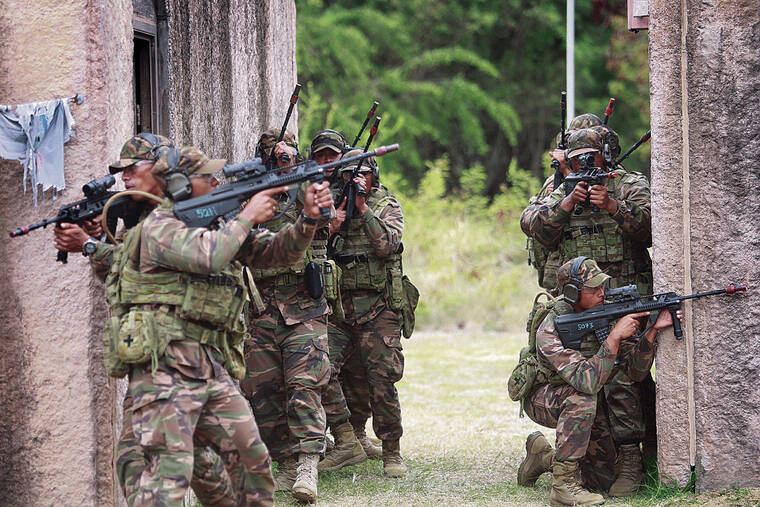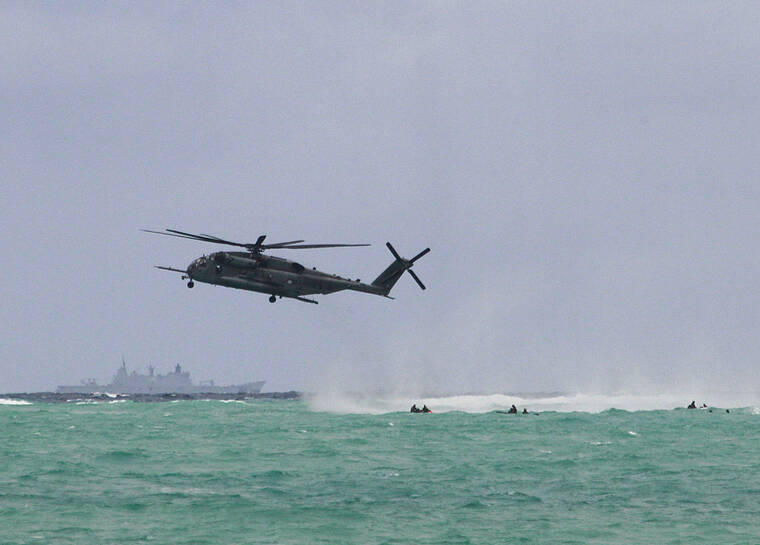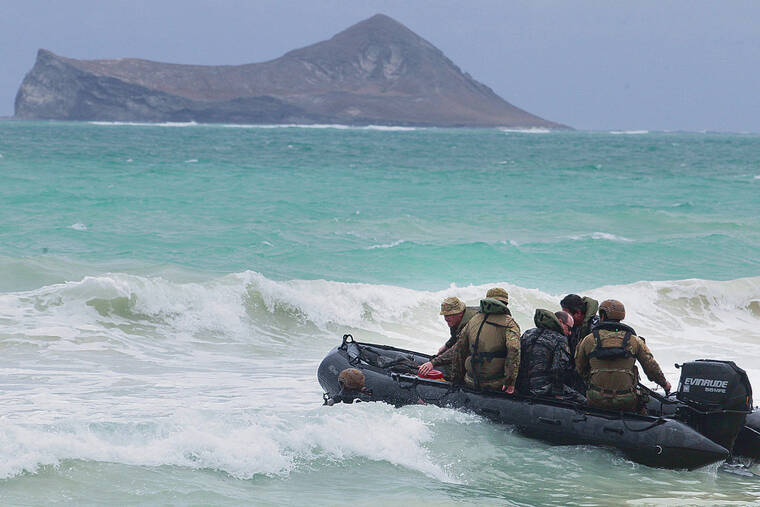On Monday afternoon at a mock village near Bellows Beach, a force of Tongan marines made its way down a narrow alleyway between two homes. As they emerged they began taking fire as blank rounds rang out.
The Tongans returned fire and took positions to begin a counterattack. But as a group of about six marines lined up forming a “stack” along a wall, their opponents lobbed a grenade. One of the marines shouted, “Grenade!” as he kicked it away.
The Tongans responded hastily, but their forces remained bunched up in the narrow alleyways that connected the buildings in the village, and grenades and enemy fire kept coming.
The drill was part of the land portion of the biennial Rim of the Pacific Exercise, the world’s largest recurring naval war game. Though the exercise focuses mostly on operations at sea, U.S. Marines are hosting land forces to practice operations in coastal settings to fight on land and make amphibious landings.
Tongan marine platoon leader Lt. Filise Saile said urban combat is complicated and that it’s been a learning experience for him and his troops.
“It’s really important because we don’t have this kind of training environment back at home,” said Saile.
The Tongans came to Hawaii aboard the Australian navy ship HMAS Canberra after two weeks of training with Australian army soldiers. Australian army troops have also come to Hawaii for RIMPAC. Just before the Tongans attempted storming the village, the Australians had made their own simulated assault.
“We like to talk about being professional soldiers,” said Lance Cpl. Charlie Price, one of the Australian soldiers who took part in the simulated attack. “But before we can start boasting about that, we’ve got to actually put in the time, put in the effort, do the drills, work together (and) find out what our friendly nations are doing.”
At another training site at Bellows, Malaysian soldiers and U.S. Marines were training on how to respond to an ambush during a patrol operation with a focus on how to protect friendly forces as well as local civilians as they respond.
U.S. Marine 1st Lt. Charlie Pruett said that his troops and the Malaysians had similar tactics and equipment but that he and his Marines have been picking up tactics and tricks from them. In particular, he praised the way that they use their hands to make physical contact with each other before making their next move.
“If they’re like in a stack outside of a door, as they go in they know exactly where everybody is,” said Pruett.
“This is an opportunity for us to bring back what we learned from all other participant countries to bring back to our country, and then we will develop more and more our techniques,” said Malaysian srmy Maj. Mohamed Fazrul.
Fazrul’s troops are members of a highly trained rapid deployment force that he said has trained extensively in urban fighting. But he said that the very different environment and mock villages the U.S. military has in Hawaii challenge his troops. “I like their environmental setup,” he said.
RIMPAC 2022 is the largest iteration of the exercise since it began in 1971 with six nations. RIMPAC 2020 was heavily scaled back as a result of fears of the spread of COVID-19, with exercises held only at sea and no troops coming ashore. But this year, amphibious operations play a central role.
On the beach, Australian army soldiers practiced coming to shore aboard inflatable rafts that were dropped by helicopter, or “helocasted,” into the water from U.S. Marine helicopters as part of training to conduct reconnaissance missions in support of a larger landing force.
“It’s important because it allows us to get there with plenty of time to conduct the reconnaissance and then allow the amphibious ships to bring the forces,” said Lt. Col. Mark Tutton, commander of the 2nd Battalion, Royal Australian Regiment. “We operate quite a lot together, and this allows us to get in a training repetition so should we need to do this mission in real time, we can.”
Tutton’s troops have wide-ranging experience around the Pacific including humanitarian relief missions, most recently in support of Operation Tonga Assist after a Jan. 15 volcanic eruption caused earthquakes and massive tsunami waves on the island nation.
Ultimately, the Marines and soldiers at Bellows are training for much larger-scale operations with the RIMPAC amphibious task force led by South Korean Navy Rear Adm. Sangmin An.
“I think that more minds are always better than fewer,” said Pruett. “So the more people that we can talk to and the more that we share tactics, the more we can figure out what the best ways to do things are so that if it ever has to happen for real, then we can bring all our boys home.”






